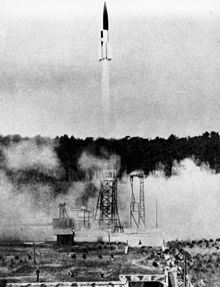Test stand VII

The Test Stand VII was the most important development, training and launch pad for A4 - rocket (known under the name "V2" ( "Vengeance Weapon 2") of the Peenemünde Army Research Center ).
description
The test stand was surrounded by an elliptical earth wall, in which the start control station was also embedded, and was therefore nicknamed "Arena". Test stand VII also included a 32-meter-high assembly hall.
The facility was managed by Kurt Debus , who organized the operational tasks into two working groups: One group was responsible for the mechanical, fluid and drive systems, the other for electrical engineering, control and instruments.
A television transmission system developed by Walter Bruch was installed on test stand VII for better tracking of the starts . This was the first application of industrial television worldwide.
Test stand VII was oversized for the A4 rocket; when construction began on test stand VII in 1938, its size was planned for the A9 / A10 rocket. Their diameter should have been 4.12 meters at the starting stage. However, no single component was ever made of the A10. The A9 / A10 rocket ("America rocket") could possibly have reached the USA .
Operating time
Test stand VII was built in 1938 and was used for test launches of A4 rockets until the HVA Peenemünde was cleared in February 1945 - despite the damage caused by the British air raid in mid-August 1943 (" Operation Hydra ") and three other air strikes by the USAAF on July 18 and August 4 and 25, 1944.
Military use of the A4 missile was not possible from test stand VII for reasons of range.
Overall, the war effort of the A4 from mobile launch ramps and from various locations claimed more than 8,000 lives, mainly civilians. The greatest number of casualties in one fell swoop was on December 16, 1944 in Antwerp, when an A4 hit the packed cinema "Rex" and killed 567 people.
A satellite concentration camp had existed in Peenemünde since June 1943 . There was also a second concentration camp, a POW camp in Karlshagen and the Trassenheide camp, which housed a total of 1,400 prisoners. At least 171 prisoners who died between November 1943 and September 1944 were cremated in the Greifswald crematorium ; other bodies were buried on site. In addition, there were numerous victims in the four Allied bombing raids on the HVA Peenemünde.
Kurt Debus, later director of the Kennedy Space Center , was the last manager of the facility when it was cleared. By the end of the launch operations on February 21, 1945, 175 rockets had been launched from test stand VII (see list of test launches ).
post war period
Between 1948 and 1961, the technical system was largely destroyed by the Soviet occupying forces. Today only sparse remains of the once huge complex are preserved.
Members of the rocket model association DERA from Berlin repeatedly launched A4 models from the test stand VII area on October 3rd. October 3rd was chosen as the date because on the same day in 1942 at 3:58 p.m. CET the first successful flight of an A4 took place here. This A4 crashed into the sea after 296 seconds of flight, previously reached a summit height of 85 km and is therefore the first object to penetrate the border area of space or the first man-made object in space (always depending on the definition of where space begins), which is why October 3, 1942 is considered the "birthday of space travel".
today
Today test stand VII in the Peenemünde Army Research Station on the Peenemünder Haken is a nature reserve. The systems are operated by the Museum Association Peenemünde e. V. maintained. Test stand VII was uncovered by the association and in 2016, German and English museum members carried out extensive geometric measurements. A three-dimensional reconstruction of the test stand was created in close cooperation. At the HVA Peenemünde, the association develops a wide variety of projects for maintenance and documentation.
See also
- List of industrial monuments
- List of test launches of the A4 rocket
- Remains of rocket launch pads in Germany
Web links
Individual evidence
- ^ A b Kurt H. Debus: Launching a Vision. (PDF; 3.2 MB) NASA
- ^ Rainer Eisfeld : Moonstruck: Wernher von Braun and the birth of space travel from the spirit of barbarism . To Klampen Verlag, Springe 2012, ISBN 978-3-86674-167-6 , p. 95 .
- ↑ Ascension on Usedom . In: Der Spiegel . No. 22 , 2001 ( online ).
- ↑ a b mass grave at the rocket ramp. Historian Jens-Christian Wagner on Heinrich Lübke's role in the deployment of concentration camp prisoners in Peenemünde . In: Der Spiegel . No. 22 , 2001, p. 218 ( online ).
Coordinates: 54 ° 10 ′ 6 ″ N , 13 ° 48 ′ 2 ″ E


